A Comprehensive Review of IoT Standards: The Role of IEEE 1451 in Smart Cities and Smart Buildings
Abstract
Highlights
- Interoperability is paramount in the context of communication between transducers. This paper aims to demonstrate the potential of the standard IEEE 1451 in resolving compatibility issues and its implications for IoT applications, particularly in the domain of smart buildings.
- We outline a framework that promotes the harmonisation of IoT applications. This harmonisation is achieved by bridging the use of different communication protocols, thereby creating an interconnected system.
- This paper provides a review of the problems related to the lack of interoperability between transducers in IoT applications, thereby creating a plug-and-play architecture that fosters ease of use and flexibility.
- IEEE 1451 enables the creation of harmonised, flexible, and compatible systems that foster interoperability among transducer networks.
Abstract
1. Introduction
- 1.
- Although there exist many semantics for transducer communications, the lack of its usage results in the absence of a language that describes what certain data received or transmitted in the transducer networks portrays.
- 2.
- The diversification of transducers delivered by different manufacturers and several types of transducers results in limited interoperability in data exchange between smart transducers.
- 3.
- There is a need for a common interface that enables a way of connecting several types of transducers and provides support for communication between devices of various communication protocols.
- 4.
- There is a lack of interoperability in transducer networks, which affects the scalability of IoT systems, resulting in a need for a system that provides ease of configuration for transducers.
- 1.
- It introduces one of the necessary components of interoperable transducer networks, with the use of the sub-standard IEEE 1451.0, which introduces the Transducer Electronic Data Sheet (TEDS). This sub-standard defines the common functions and a transducer data sheet that stores valuable information (such as a few manufacturers, the type of communication, and the parameter read) about the set transducer, enabling the information from the transducers to be comprehensible.
- 2.
- It considers the absence of a common interface, it offers a solution using the IEEE 1451.0 sub-standard, which defines a middleware component that provides a way to connect diverse types of sensors and actuators while also enabling different communication protocols to be used.
- 3.
- With the introduction of TEDS, transducers will need dedicated non-volatile memory to store the TEDS information, or a file delivered by the manufacturer to the user (Virtual TEDS), which will allow for the NCAP to read the TEDS and send the necessary commands to configure the transducers, which enables plug-and-play capabilities and the ease of scalability of transducer networks.
2. Identified Related Research Works
3. Smart Cities Components, Applications, and Standards
3.1. Standard Deployment in Smart City Components
3.2. Applications in Smart Cities
3.2.1. Smart Agriculture
3.2.2. Smart Industry
3.2.3. Smart Infrastructure
3.2.4. Smart Energy
3.2.5. Smart Transportation
3.2.6. Smart Building
3.2.7. Smart Services
3.2.8. Smart Health
4. Fundamental Concepts of the IEEE 1451 Standard
4.1. IEEE 1451 Standard
4.1.1. IEEE 1451 Standard and Its Main Components
- Calibration data;
- Information about manufacturers;
- Range of measurements;
- Type of sensor or actuator;
- Communication protocol.
4.1.2. NCAP
4.1.3. TIM
4.1.4. Transducer Interface
4.1.5. Network Interface
4.1.6. Transducer Channel
4.1.7. Transducer Channel Proxy
4.1.8. TEDS
- Meta-TEDS;
- Transducer Channel TEDS;
- Users Transducer Name TEDS;
- PHY TEDS.
4.1.9. IEEE 1451 Example System
4.2. IEEE 1451 Collection of Sub-Standards
5. Building Automation
5.1. Introduction to Building Automation
5.2. Enhancing Interoperability in Smart Buildings: The Role of IEEE 1451 Standard
6. Conclusions
Author Contributions
Funding
Data Availability Statement
Conflicts of Interest
References
- Hofer-Schmitz, K.; Stojanović, B. Towards Formal Verification of IoT Protocols: A Review. Comput. Netw. 2020, 174, 107233. [Google Scholar] [CrossRef]
- IEEE Std 1888.2-2014; IEEE Standard for Ubiquitous Green Community Control Network: Heterogeneous Networks Convergence and Scalability. IEEE: Piscataway, NJ, USA, 2014; pp. 1–48. [CrossRef]
- Da Rocha, H.; Abrishambaf, R.; Pereira, J.; Espirito Santo, A. Integrating the IEEE 1451 and IEC 61499 Standards with the Industrial Internet Reference Architecture. Sensors 2022, 22, 1495. [Google Scholar] [CrossRef] [PubMed]
- The Industrial Internet of Things Volume G1: Reference Architecture, Version 1.9; Industrial Internet Consortium: Needham, MA, USA, 2019; p. 58.
- IEEE Std 1451.0-2024 (Revision of 1451.0-2007); IEEE Standard for a Smart Transducer Interface for Sensors and Actuators–Common Functions, Communication Protocols, and Transducer Electronic Data Sheet (TEDS) Formats. IEEE: Piscataway, NJ, USA, 2024; pp. 1–429. [CrossRef]
- Syed, A.S.; Sierra-Sosa, D.; Kumar, A.; Elmaghraby, A. IoT in smart Cities: A Survey of Technologies, Practices and Challenges. Smart Cities 2021, 4, 429–475. [Google Scholar] [CrossRef]
- Ali, J.; Zafar, M.H.; Hewage, C.; Hassan, S.R.; Asif, R. The Advents of Ubiquitous Computing in the Development of smart Cities—A Review on the Internet of Things (IoT). Electronics 2023, 12, 1032. [Google Scholar] [CrossRef]
- Lee, E.; Seo, Y.-D.; Oh, S.-R.; Kim, Y.-G. A Survey on Standards for Interoperability and Security in the Internet of Things. IEEE Commun. Surv. Tutor. 2021, 23, 1020–1047. [Google Scholar] [CrossRef]
- Rawajbeh, M.A.; AlZu’bi, S.; Alkhatib, A. IoT-Paradigm: Evolution Challenges and Proposed Solutions. In Proceedings of the 2023 IEEE International Smart Cities Conference (ISC2), Bucharest, Romania, 24–27 September 2023; IEEE: Piscataway, NJ, USA, 2023; pp. 1–5. [Google Scholar]
- Eck, N.; Waltman, L. VOSviewer. Available online: https://www.vosviewer.com/ (accessed on 9 June 2025).
- ISO/IEC/IEEE 24765:2017(E); ISO/IEC/IEEE International Standard—Systems and Software Engineering–Vocabulary. IEEE: Piscataway, NJ, USA, 2017; pp. 1–541. [CrossRef]
- Aldin, H.N.S.; Ghods, M.R.; Nayebipour, F.; Torshiz, M.N. A Comprehensive Review of Energy Harvesting and Routing Strategies for IoT Sensors Sustainability and Communication Technology. Sens. Int. 2024, 5, 100258. [Google Scholar] [CrossRef]
- Risteska Stojkoska, B.L.; Trivodaliev, K.V. A Review of Internet of Things for smart Home: Challenges and Solutions. J. Clean. Prod. 2017, 140, 1454–1464. [Google Scholar] [CrossRef]
- Karie, N.M.; Sahri, N.M.; Yang, W.; Valli, C.; Kebande, V.R. A Review of Security Standards and Frameworks for IoT-Based smart Environments. IEEE Access 2021, 9, 121975–121995. [Google Scholar] [CrossRef]
- Anitha, T.; Manimurugan, S.; Sridhar, S.; Mathupriya, S.; Latha, G.C.P. A Review on Communication Protocols of Industrial Internet of Things. In Proceedings of the 2022 2nd International Conference on Computing and Information Technology (ICCIT), Tabuk, Saudi Arabia, 25–27 January 2022; IEEE: Piscataway, NJ, USA, 2022; pp. 418–423. [Google Scholar]
- Alqahtani, B.; AlNajrani, B. A Study of Internet of Things Protocols and Communication. In Proceedings of the 2020 2nd International Conference on Computer and Information Sciences (ICCIS), Sakaka, Saudi Arabia, 13–15 October 2020; IEEE: Piscataway, NJ, USA, 2020; pp. 1–6. [Google Scholar]
- Saadhikha Shree, S.; Florence Gnana Poovathy, J. Communication Technologies in IoT and Related Concepts: A Review. In Proceedings of the 2022 Third International Conference on Intelligent Computing Instrumentation and Control Technologies (ICICICT), Kannur, India, 11–12 August 2022; IEEE: Piscataway, NJ, USA, 2022; pp. 310–314. [Google Scholar]
- Al-Sarawi, S.; Anbar, M.; Alieyan, K.; Alzubaidi, M. Internet of Things (IoT) Communication Protocols: Review. In Proceedings of the 2017 8th International Conference on Information Technology (ICIT), Amman, Jordan, 17–18 May 2017; IEEE: Piscataway, NJ, USA, 2017; pp. 685–690. [Google Scholar]
- Kaur, K.; Gandhi, V. Internet of Things: A Study on Protocols, Security Challenges and Healthcare Applications. In Proceedings of the 2022 2nd International Conference on Advance Computing and Innovative Technologies in Engineering (ICACITE), Greater Noida, India, 28–29 April 2022; IEEE: Piscataway, NJ, USA, 2022; pp. 1206–1210. [Google Scholar]
- Changazi, S.A.; Bakhshi, A.D.; Yousaf, M.; Mohsin, S.M.; Akber, S.M.A.; Abazeed, M.; Ali, M. Optimization of Network Topology Robustness in IoTs: A Systematic Review. Comput. Netw. 2024, 250, 110568. [Google Scholar] [CrossRef]
- Habibzadeh, H.; Soyata, T.; Kantarci, B.; Boukerche, A.; Kaptan, C. Sensing, Communication and Security Planes: A New Challenge for a Smart City System Design. Comput. Netw. 2018, 144, 163–200. [Google Scholar] [CrossRef]
- Kumar, N.V.R.; Kumar, P.M. Survey on State of Art IoT Protocols and Applications. In Proceedings of the 2020 International Conference on Computational Intelligence for Smart Power System and Sustainable Energy (CISPSSE), Keonjhar, India, 29–31 July 2020; IEEE: Piscataway, NJ, USA, 2020; pp. 1–3. [Google Scholar]
- Nishandhi, S.; Vidhya, J.; Ragasudha, I.; Vishnupriya, M. Survey on Various IOT Standard Protocols and Its Applications. In Proceedings of the 2020 International Conference on System, Computation, Automation and Networking (ICSCAN), Pondicherry, India, 3–4 July 2020; IEEE: Piscataway, NJ, USA, 2020; pp. 1–5. [Google Scholar]
- Atzori, L.; Iera, A.; Morabito, G. The Internet of Things: A Survey. Comput. Netw. 2010, 54, 2787–2805. [Google Scholar] [CrossRef]
- Mylonas, G.; Kalogeras, A.; Kalogeras, G.; Anagnostopoulos, C.; Alexakos, C.; Munoz, L. Digital Twins From smart Manufacturing to smart Cities: A Survey. IEEE Access 2021, 9, 143222–143249. [Google Scholar] [CrossRef]
- Madolia, J.; Rawat, P.; Pandey, S.; Sahu, M.; Kumar, G.R.; Patet, N. Ensuring Resident Well-Being: IoT Solution for Shelter Home Security and Welfare. In Proceedings of the 2023 International Conference on Power Energy, Environment & Intelligent Control (PEEIC), Greater Noida, India, 19–23 December 2023; IEEE: Piscataway, NJ, USA, 2023; pp. 238–242. [Google Scholar]
- Sharmila Kumari, N.; Vimala, H.S.; Pruthvi, C.N.; Shreyas, J. Holistic Survey on Security in IoT Application Layer: Attacks, Protocols, and Applications. IEEE Access 2024, 12, 186957–187014. [Google Scholar] [CrossRef]
- Iqbal, M.W.; Khaliq, K.; Al-Dmour, N.A.; Aqeel, M.; Ali, N.; Hamid, K. Internet of Things (IoT) in smart Cities: A Statistical Survey. In Proceedings of the 2023 International Conference on Business Analytics for Technology and Security (ICBATS), Dubai, United Arab Emirates, 7–8 March 2023; IEEE: Piscataway, NJ, USA, 2023; pp. 1–6. [Google Scholar]
- Meydani, A.; Ramezani, A.; Meidani, A. The Internet of Things-Enabled smart City: An In-Depth Review of Its Domains and Applications. In Proceedings of the 2023 13th International Conference on Computer and Knowledge Engineering (ICCKE), Mashhad, Iran, 1–2 November 2023; IEEE: Piscataway, NJ, USA, 2023; pp. 613–622. [Google Scholar]
- Belli, L.; Cilfone, A.; Davoli, L.; Ferrari, G.; Adorni, P.; Di Nocera, F.; Dall’Olio, A.; Pellegrini, C.; Mordacci, M.; Bertolotti, E. IoT-Enabled smart Sustainable Cities: Challenges and Approaches. Smart Cities 2020, 3, 1039–1071. [Google Scholar] [CrossRef]
- Pliatsios, A.; Kotis, K.; Goumopoulos, C. A Systematic Review on Semantic Interoperability in the IoE-Enabled smart Cities. Internet Things 2023, 22, 100754. [Google Scholar] [CrossRef]
- Peralta Abadía, J.J.; Walther, C.; Osman, A.; Smarsly, K. A Systematic Survey of Internet of Things Frameworks for smart City Applications. Sustain. Cities Soc. 2022, 83, 103949. [Google Scholar] [CrossRef]
- Choudhary, V.; Guha, P.; Pau, G.; Mishra, S. An Overview of smart Agriculture Using Internet of Things (IoT) and Web Services. Environ. Sustain. Indic. 2025, 26, 100607. [Google Scholar] [CrossRef]
- Rayes, A.; Salam, S. Internet of Things from Hype to Reality: The Road to Digitization; Springer International Publishing: Cham, Switzerland, 2019; ISBN 978-3-319-99515-1. [Google Scholar]
- oneM2M oneM2M Framework. Available online: https://www.onem2m.org/ (accessed on 9 June 2025).
- Eclipse Foundation Eclipse sensiNact. Available online: https://projects.eclipse.org/projects/technology.sensinact (accessed on 9 June 2025).
- IoTivity IoTivity-Open Source Framework for IoT Devices. Available online: https://iotivity.org/about/ (accessed on 9 June 2025).
- FIWARE Foundation FIWARE—A Curated Framework of Open Source Platform Components to Accelerate the Development of smart Solutions. Available online: https://www.fiware.org/about-us/ (accessed on 9 June 2025).
- ISO/IEC Information Technology—Open Systems Interconnection—Basic Reference Model: The Basic Model. Available online: https://www.iso.org/standard/20269.html?browse=ics (accessed on 9 June 2025).
- Xiao, W.; Liu, C.; Wang, H.; Zhou, M.; Hossain, M.S.; Alrashoud, M.; Muhammad, G. Blockchain for Secure-GaS: Blockchain-Powered Secure Natural Gas IoT System with AI-Enabled Gas Prediction and Transaction in smart City. IEEE Internet Things J. 2021, 8, 6305–6312. [Google Scholar] [CrossRef]
- Gabbar, H.A. Chapter 2—Smart Energy Grid Infrastructures and Interconnected Micro Energy Grids. In Smart Energy Grid Engineering; Gabbar, H.A., Ed.; Academic Press: Cambridge, MA, USA, 2017; pp. 23–45. ISBN 978-0-12-805343-0. [Google Scholar]
- Pathak, S.; Pandey, M. Smart Cities: Review of Characteristics, Composition, Challenges and Technologies. In Proceedings of the 2021 6th International Conference on Inventive Computation Technologies (ICICT), Coimbatore, India, 20–22 January 2021; IEEE: Piscataway, NJ, USA, 2021; pp. 871–876. [Google Scholar]
- Matyakubov, M.; Rustamova, O. Development of smart City Model: Smart Bus System. In Proceedings of the 2019 International Conference on Information Science and Communications Technologies (ICISCT), Tashkent, Uzbekistan, 4–6 November 2019; IEEE: Piscataway, NJ, USA, 2019; pp. 1–5. [Google Scholar]
- Prabha, C.; Mittal, P.; Sharma, A.; Singh, J. AIoT Emerging Technologies, Use Cases, and Its Challenges in Implementing smart Cities. In Proceedings of the 2022 IEEE North Karnataka Subsection Flagship International Conference (NKCon), Vijaypur, India, 20–21 November 2022; IEEE: Piscataway, NJ, USA, 2022; pp. 1–5. [Google Scholar]
- Bellini, P.; Nesi, P.; Pantaleo, G. IoT-Enabled smart Cities: A Review of Concepts, Frameworks and Key Technologies. Appl. Sci. 2022, 12, 1607. [Google Scholar] [CrossRef]
- Sharma, D.R.; Mishra, V.; Srivastava, S. Enhancing Crop Yields through IoT-Enabled Precision Agriculture. In Proceedings of the 2023 International Conference on Disruptive Technologies (ICDT), Greater Noida, India, 11–12 May 2023; IEEE: Piscataway, NJ, USA, 2023; pp. 279–283. [Google Scholar]
- Cornei, D.; Fosalau, C. Using IoT in smart Agriculture: Study about Practical Realizations and Testing in a Real Environment. In Proceedings of the 2022 International Conference and Exposition on Electrical and Power Engineering (EPE), Iasi, Romania, 20–22 October 2022; IEEE: Piscataway, NJ, USA, 2023; pp. 013–018. [Google Scholar]
- Enriko, I.K.A.; Gustiyana, F.N. Wi-Fi HaLow: Literature Review About Potential Use of Technology In Agriculture and smart Cities in Indonesia. In Proceedings of the 2024 International Conference on Green Energy, Computing and Sustainable Technology (GECOST), Miri Sarawak, Malaysia, 17–19 January 2024; IEEE: Piscataway, NJ, USA, 2024; pp. 277–281. [Google Scholar]
- Saivarun, K.; Ramakrishnan, R.; Kishore, M. Iot Based smart Industry Monitoring and Alerting System. In Proceedings of the 2022 International Interdisciplinary Humanitarian Conference for Sustainability (IIHC), Bengaluru, India, 18–19 November 2022; IEEE: Piscataway, NJ, USA, 2022; pp. 1108–1111. [Google Scholar]
- Awad, A.H.; Saraya, M.S.; Elksasy, M.S.M.; Ali-Eldin, A.M.T. IoT Based Framework for Monitoring and Controlling Movable Harbor Cranes. In Proceedings of the 2021 International Mobile, Intelligent, and Ubiquitous Computing Conference (MIUCC), Cairo, Egypt, 26–27 May 2021; IEEE: Piscataway, NJ, USA, 2021; pp. 42–47. [Google Scholar]
- Pies, M.; Velicka, J.; Hajovsky, R. Advanced IoT-Based Wireless Sensors for Remote Geotechnical Monitoring and Structural Diagnostics. IFAC-PapersOnLine 2024, 58, 193–198. [Google Scholar] [CrossRef]
- AbdelRaheem, M.; Hassan, M.; Mohammed, U.S.; Nassr, A.A. Design and Implementation of a Synchronized IoT-Based Structural Health Monitoring System. Internet Things 2022, 20, 100639. [Google Scholar] [CrossRef]
- Kamal, P.; Raw, R.S.; Singh, N.; Kumar, S.; Kumar, A. VANET Based Health Monitoring through Wireless Body Sensor Network. In Proceedings of the 2014 International Conference on Computing for Sustainable Global Development (INDIACom), New Delhi, India, 5–7 March 2014; IEEE: Piscataway, NJ, USA, 2014. [Google Scholar]
- Barrero, F.; Guevara, J.A.; Vargas, E.; Toral, S.; Vargas, M. Networked Transducers in Intelligent Transportation Systems Based on the IEEE 1451 Standard. Comput. Stand. Interfaces 2014, 36, 300–311. [Google Scholar] [CrossRef]
- Marroquin, A.; Gomez, A.; Carias, H.; Bran, C. Energy Meter Proposal for Residential smart Grid Based on IoT Technologies. In Proceedings of the 2022 IEEE International Conference on Automation/XXV Congress of the Chilean Association of Automatic Control (ICA-ACCA), Curicó, Chile, 24–28 October 2022; IEEE: Piscataway, NJ, USA, 2022; pp. 1–4. [Google Scholar]
- Hou, Y.; Cai, Z.; Zhang, Y.; Cheng, Y.; Yang, J.; Chen, F.; Zhang, J. A Solar Powered General Purpose IoT Node for smart Grid Applications. In Proceedings of the 2024 6th International Conference on Circuits and Systems (ICCS), Chengdu, China, 20–23 September 2024; IEEE: Piscataway, NJ, USA, 2024; pp. 306–309. [Google Scholar]
- Noman, A.A.; Baidya, P.; Hossain, M.A.; Dev, P.; Saha, K.; Hossain, M.L. Design and Implementation IoT-Driven Distribution Transformer Health Monitoring System for the smart Power Grid. In Proceedings of the ASEC 2024, Online, 4–6 December 2024; p. 27. [Google Scholar]
- Hamzah, H.A.; Abdul-Rahaim, L.A. Design and Implementation of Fire Alarm for Big City Based on Cloud Computing System. In Proceedings of the 2022 2nd International Conference on Advances in Engineering Science and Technology (AEST), Babil, Iraq, 24–25 October 2022; IEEE: Piscataway, NJ, USA, 2022; pp. 622–627. [Google Scholar]
- Rosati, C.A.; Cervo, A.; Fantuzzi, C. Air Quality Monitoring in a BIM Model by Means of a IoT Sensors Network. In Proceedings of the 2020 Fourth International Conference on I-SMAC (IoT in Social, Mobile, Analytics and Cloud) (I-SMAC), Palladam, India, 7–9 October 2020; IEEE: Piscataway, NJ, USA, 2020; pp. 110–115. [Google Scholar]
- Zebari, F.M.-A.; Er, M.B. Power Saving, Safety and Remote Controlling smart Building Based on IoT. In Proceedings of the 2021 2nd International Informatics and Software Engineering Conference (IISEC), Ankara, Turkey, 16–17 December 2021; IEEE: Piscataway, NJ, USA, 2021; pp. 1–6. [Google Scholar]
- Loukil, R.; Bedioui, N.; Oueslati, H.; Hazami, M. Design and Implementation of an IoT Solution for Energy Management (smart Building Application). In Proceedings of the 2023 14th International Renewable Energy Congress (IREC), Sousse, Tunisia, 16–18 December 2023; IEEE: Piscataway, NJ, USA, 2023; pp. 1–6. [Google Scholar]
- Singh, U.; Sharad, A. The smart City: A Holistic Approach. In Proceedings of the 2020 11th International Conference on Computing, Communication and Networking Technologies (ICCCNT), Kharagpur, India, 1–3 July 2020; IEEE: Piscataway, NJ, USA, 2020; pp. 1–7. [Google Scholar]
- Gnanapriya, P.; Gajula, K.; Dudekula, R.; Naga Maheswara, R.; Sakthimohan, M.; Elizabeth Rani, G. Smart Sewers: Streamlining Industrial Wastewater Management Using IoT. In Proceedings of the 2024 2nd International Conference on Networking and Communications (ICNWC), Chennai, India, 2–4 April 2024; IEEE: Piscataway, NJ, USA, 2024; pp. 1–5. [Google Scholar]
- Mohamed, A.; ElSayed, Y.; Mahasneh, H.; Rohouma, W.M.; Otoom, A.A. Intelligent Trash Bin for smart Cities. In Proceedings of the 2023 1st International Conference on Advanced Innovations in Smart Cities (ICAISC), Jeddah, Saudi Arabia, 23–25 January 2023; IEEE: Piscataway, NJ, USA, 2023; pp. 1–4. [Google Scholar]
- Modani, B.; Sagar; Cyril, C.P.D. IoT Based Voice Controlled smart Health Sensor System. In Proceedings of the 2021 Fifth International Conference on I-SMAC (IoT in Social, Mobile, Analytics and Cloud) (I-SMAC), Palladam, India, 11–13 November 2021; IEEE: Piscataway, NJ, USA, 2021; pp. 263–266. [Google Scholar]
- Thivyabrabha, K.; Saranya, C.; Aakash, R.; Abishek, T.; Mohamed Hussain, S. smart Health Monitoring for Comatose Patients: Integrating IoT and Real-Time Alerts. In Proceedings of the 2024 8th International Conference on Electronics, Communication and Aerospace Technology (ICECA), Coimbatore, India, 6–8 November 2024; IEEE: Piscataway, NJ, USA, 2024; pp. 462–466. [Google Scholar]
- Al-Mahmud, O.; Khan, K.; Roy, R.; Mashuque Alamgir, F. Internet of Things (IoT) Based smart Health Care Medical Box for Elderly People. In Proceedings of the 2020 International Conference for Emerging Technology (INCET), Belgaum, India, 5–7 June 2020; IEEE: Piscataway, NJ, USA, 2020; pp. 1–6. [Google Scholar]
- IEEE Std 1451.5-2007; IEEE Standard for a Smart Transducer Interface for Sensors and Actuator—Wireless Communication Protocols and Transducer Electronic Data Sheet (TEDS) Formats. IEEE: Piscataway, NJ, USA, 2007; pp. 1–225. [CrossRef]
- ISO/IEC/IEEE 21451-1:2010(E); ISO/IEC/IEEE Information Technology—Smart Transducer Interface for Sensors and Actuators—Part 1: Network Capable Application Processor (NCAP) Information Model. IEEE: Piscataway, NJ, USA, 2010; pp. 1–356. [CrossRef]
- ISO/IEC/IEEE 21451-2:2010(E); ISO/IEC/IEEE International Standard for Information Technology—Smart Transducer Interface for Sensors and Actuators—Part 2: Transducer to Microprocessor Communication Protocols and Transducer Electronic Data Sheet (TEDS) Formats. IEEE: Piscataway, NJ, USA, 2010; pp. 1–130. [CrossRef]
- IEEE P1451.99; Standard for Harmonization of Internet of Things (IoT) Systems Interactions. IEEE Standards Association: Piscataway, NJ, USA, 2024. Available online: https://standards.ieee.org/ieee/1451.99/11634/ (accessed on 10 June 2025).
- IEEE P1451.1.6/D04, March 2025; IEEE Draft Standard for a Smart Transducer Interface for Sensors, Actuators, and Devices—Message Queue Telemetry Transport (MQTT) for Networked Device Communication. IEEE: Piscataway, NJ, USA, 2025; pp. 1–83.
- IEEE Std 1451.2-1997; IEEE Standard for a Smart Transducer Interface for Sensors and Actuators—Transducer to Microprocessor Communication Protocols and Transducer Electronic Data Sheet (TEDS) Formats. IEEE: Piscataway, NJ, USA, 1998; pp. 1–120. [CrossRef]
- IEEE Std 1451.4-2004; IEEE Standard for A Smart Transducer Interface for Sensors and Actuators–Mixed-Mode Communication Protocols and Transducer Electronic Data Sheet (TEDS) Formats. IEEE: Piscataway, NJ, USA, 2004; pp. 1–454. [CrossRef]
- IEEE 1451.5.5; Standard for a Smart Transducer Interface for Sensors and Actuator—Wireless Communication Protocols and Transducer Electronic Data Sheet (TEDS) Formats—LoRa Protocol. IEEE Standards Association: Piscataway, NJ, USA, 2021. Available online: https://standards.ieee.org/ieee/1451.5.5/10611/ (accessed on 10 June 2025).
- IEEE 1451.5.6; Standard for a Smart Transducer Interface for Sensors and Actuator—Wireless Communication Protocols and Transducer Electronic Data Sheet (TEDS) Formats—SigFox Protocol. IEEE Standards Association: Piscataway, NJ, USA, 2021. Available online: https://standards.ieee.org/ieee/1451.5.6/10612/ (accessed on 10 June 2025).
- IEEE 1451.5.10; Standard for a Smart Transducer Interface for Sensors and Actuator—Wireless Communication Protocols and Transducer Electronic Data Sheet (TEDS) Formats—NB-IoT Protocol. IEEE Standards Association: Piscataway, NJ, USA, 2021. Available online: https://standards.ieee.org/ieee/1451.5.10/10613/ (accessed on 10 June 2025).
- IEEE Std 1451.7-2010; IEEE Standard for Smart Transducer Interface for Sensors and Actuators–Transducers to Radio Frequency Identification (RFID) Systems Communication Protocols and Transducer Electronic Data Sheet Formats. IEEE: Piscataway, NJ, USA, 2010; pp. 1–99. [CrossRef]
- Jabbar, W.A.; Kian, T.K.; Ramli, R.M.; Zubir, S.N.; Zamrizaman, N.S.M.; Balfaqih, M.; Shepelev, V.; Alharbi, S. Design and Fabrication of smart Home with Internet of Things Enabled Automation System. IEEE Access 2019, 7, 144059–144074. [Google Scholar] [CrossRef]
- Asadullah, M.; Raza, A. An Overview of Home Automation Systems. In Proceedings of the 2016 2nd International Conference on Robotics and Artificial Intelligence (ICRAI), Rawalpindi, Pakistan, 1–2 November 2016; IEEE: Piscataway, NJ, USA, 2016; pp. 27–31. [Google Scholar]
- Brush, A.J.B.; Lee, B.; Mahajan, R.; Agarwal, S.; Saroiu, S.; Dixon, C. Home Automation in the Wild: Challenges and Opportunities. In Proceedings of the SIGCHI Conference on Human Factors in Computing Systems, Vancouver, BC, Canada, 7–12 May 2011; ACM: New York, NY, USA, 2011; pp. 2115–2124. [Google Scholar]
- Grisostomi, M.; Ciabattoni, L.; Prist, M.; Romeo, L.; Ippoliti, G.; Longhi, S. Modular Design of a Novel Wireless Sensor Node for smart Environments. In Proceedings of the 2014 IEEE/ASME 10th International Conference on Mechatronic and Embedded Systems and Applications (MESA), Senigallia, Italy, 10–12 September 2014; IEEE: Piscataway, NJ, USA, 2014; pp. 1–5. [Google Scholar]
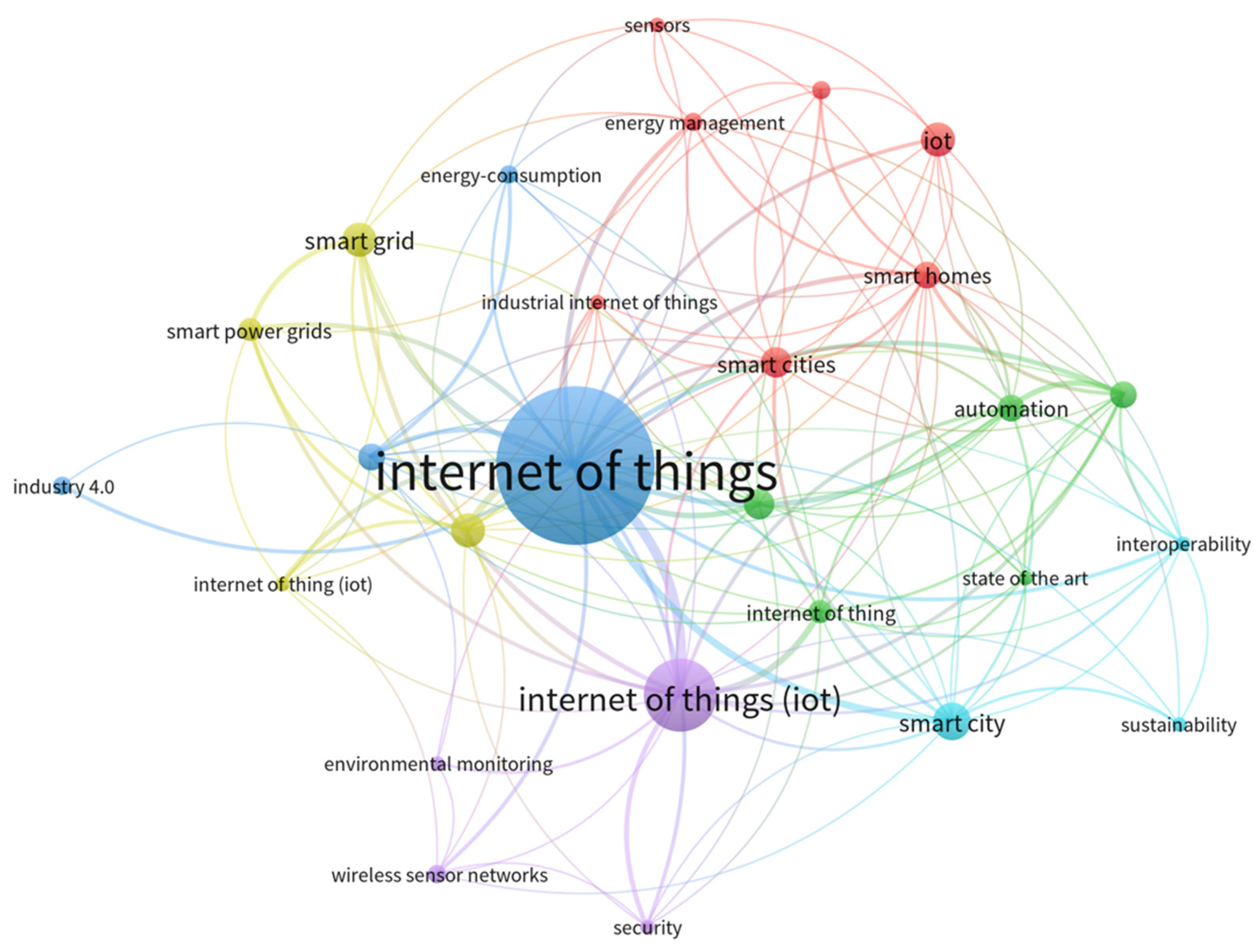
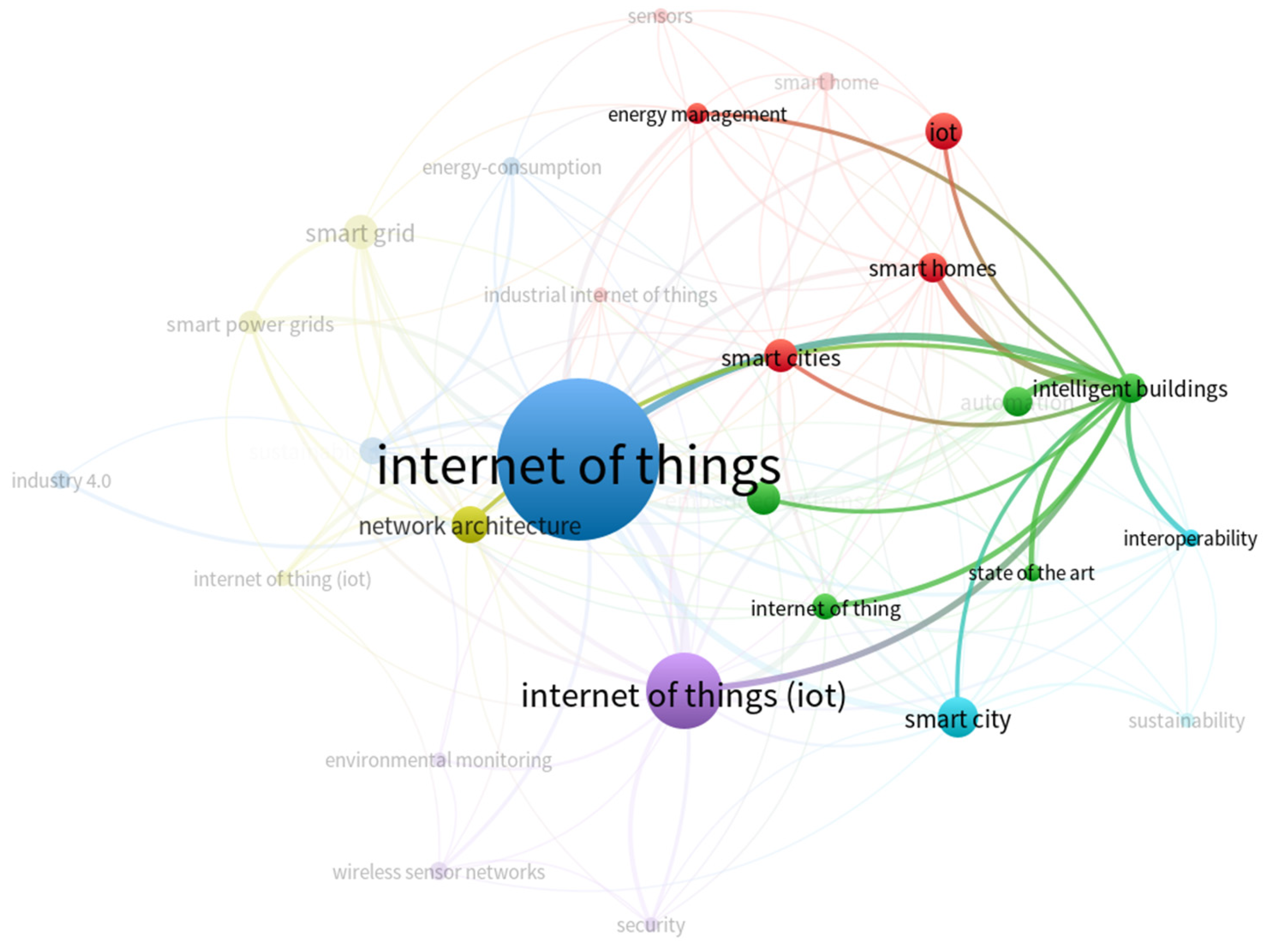
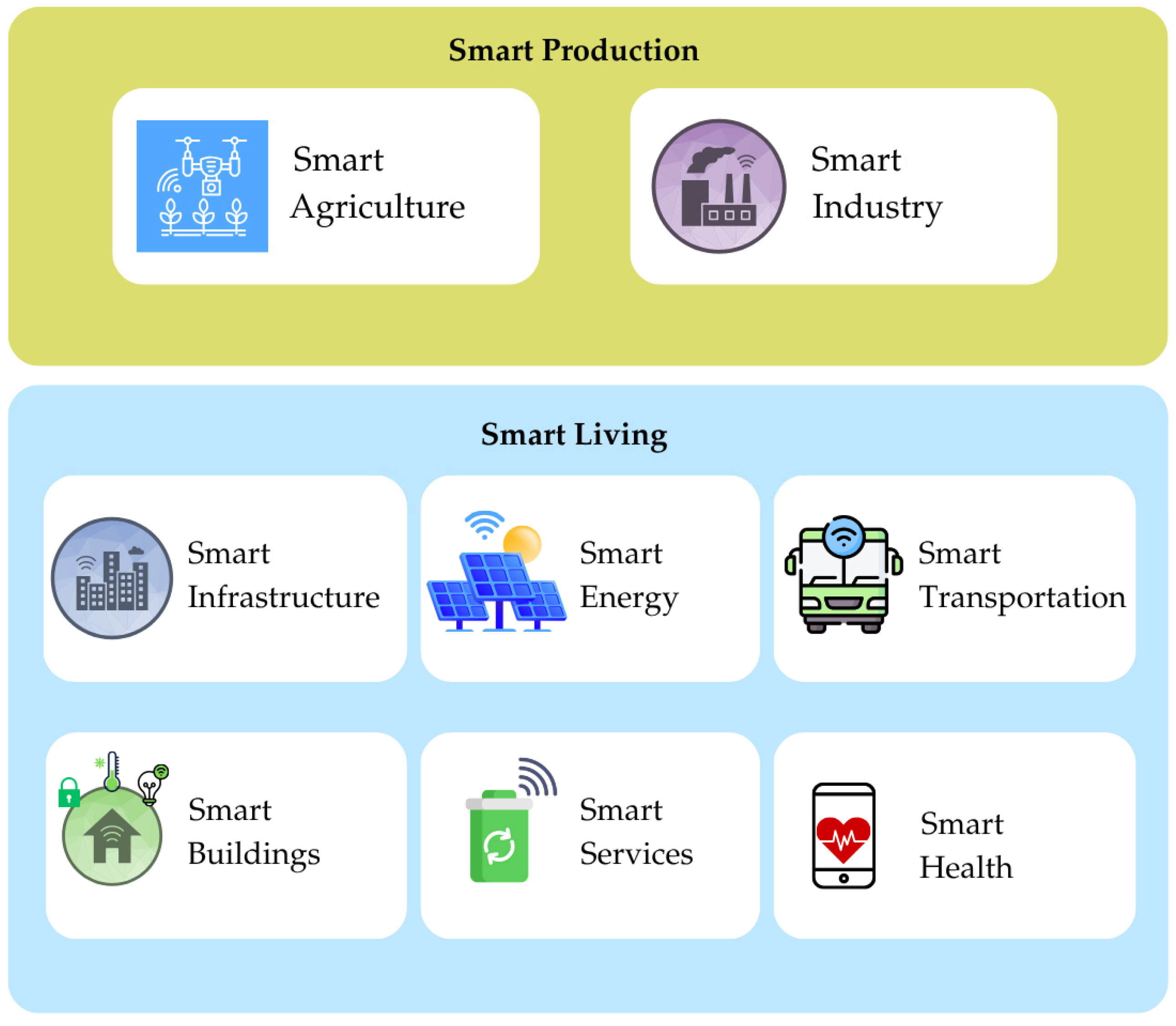
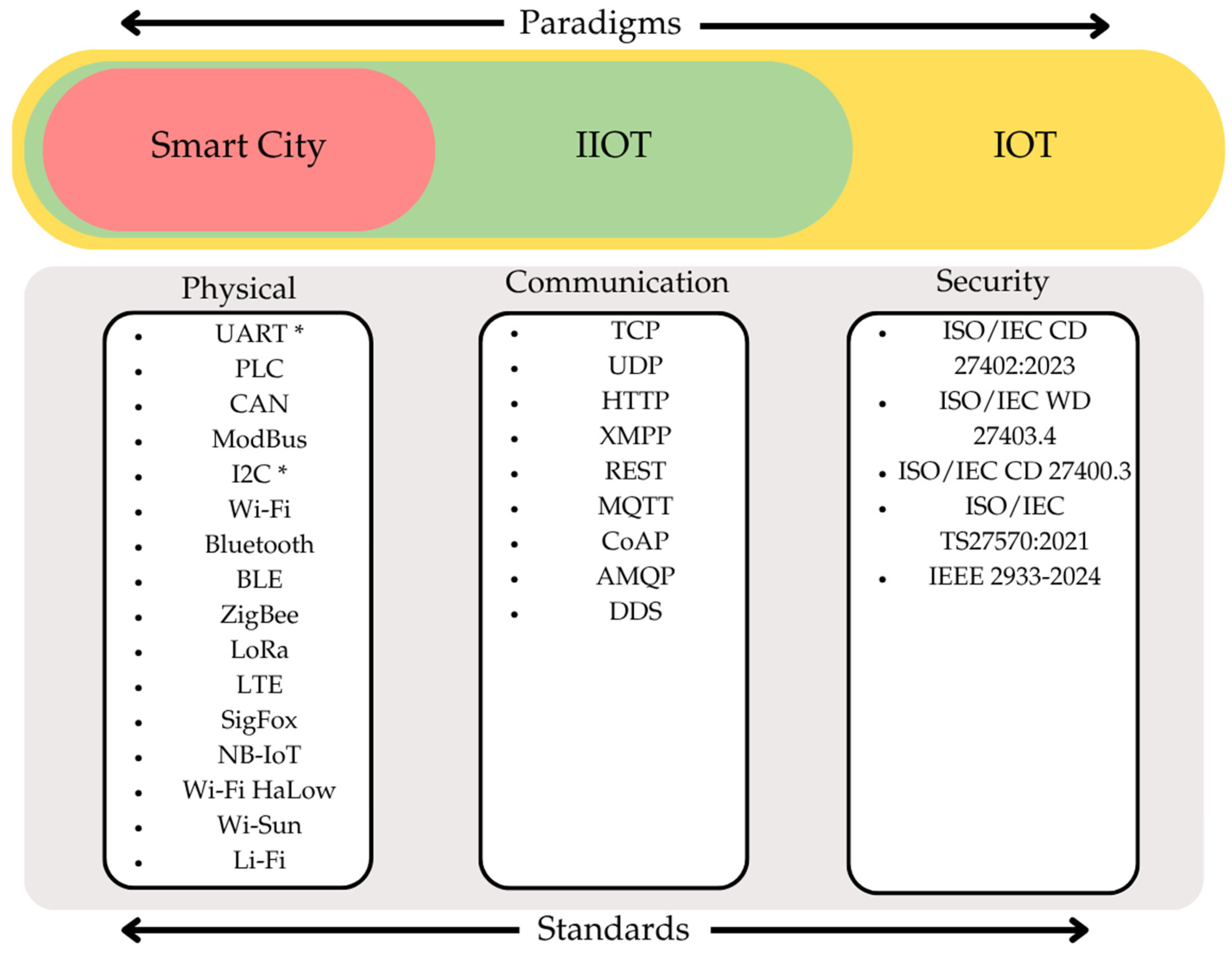
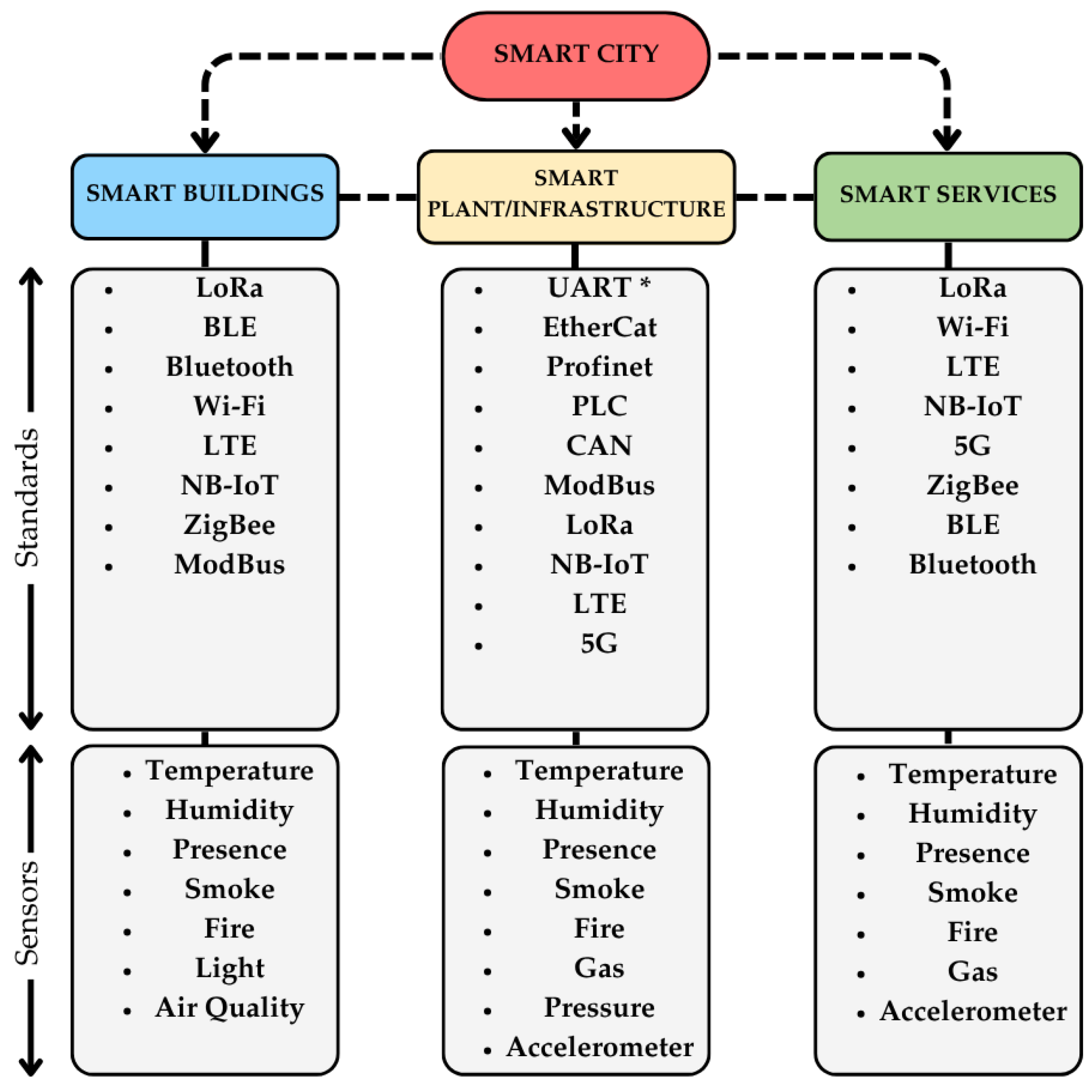
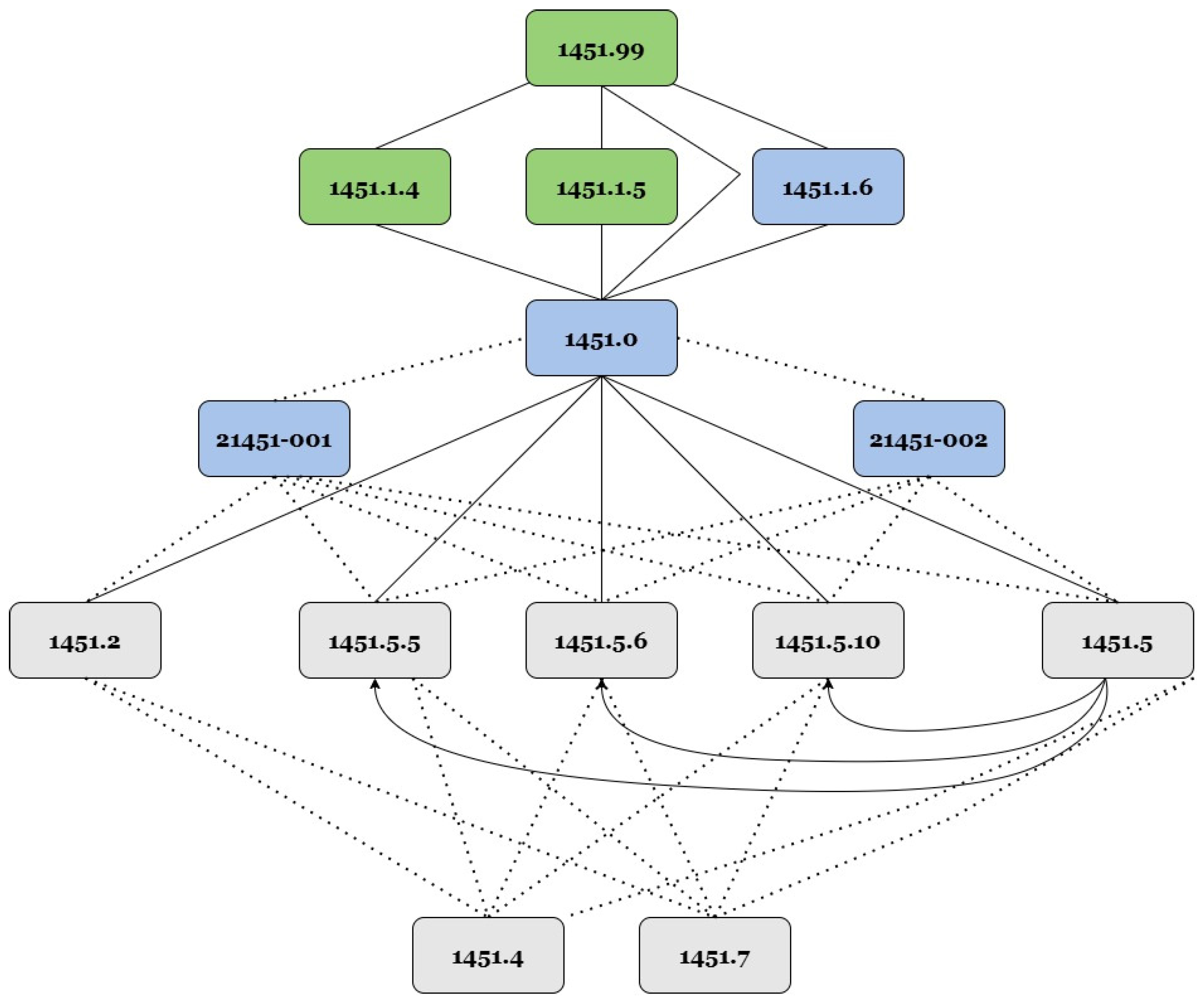
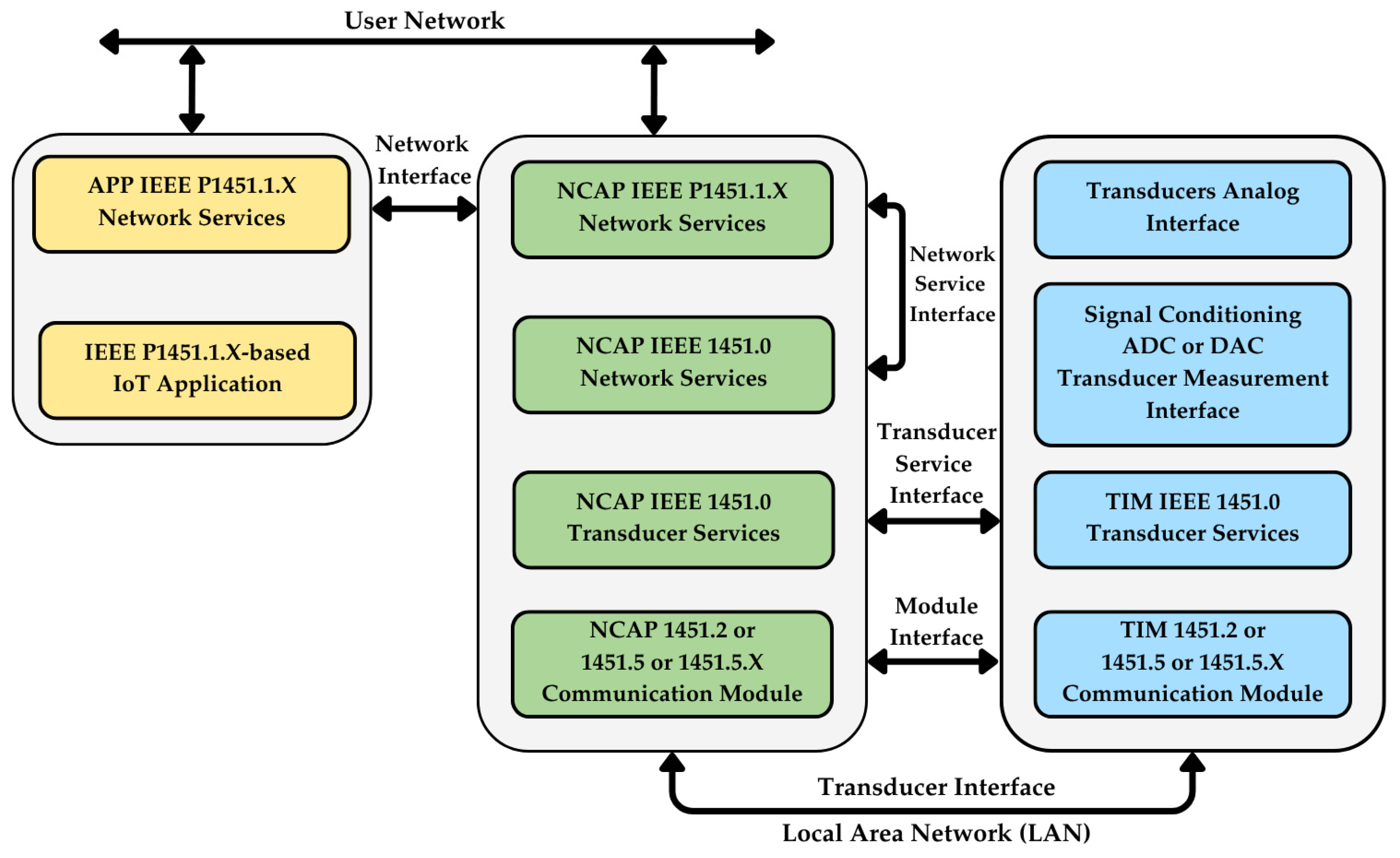
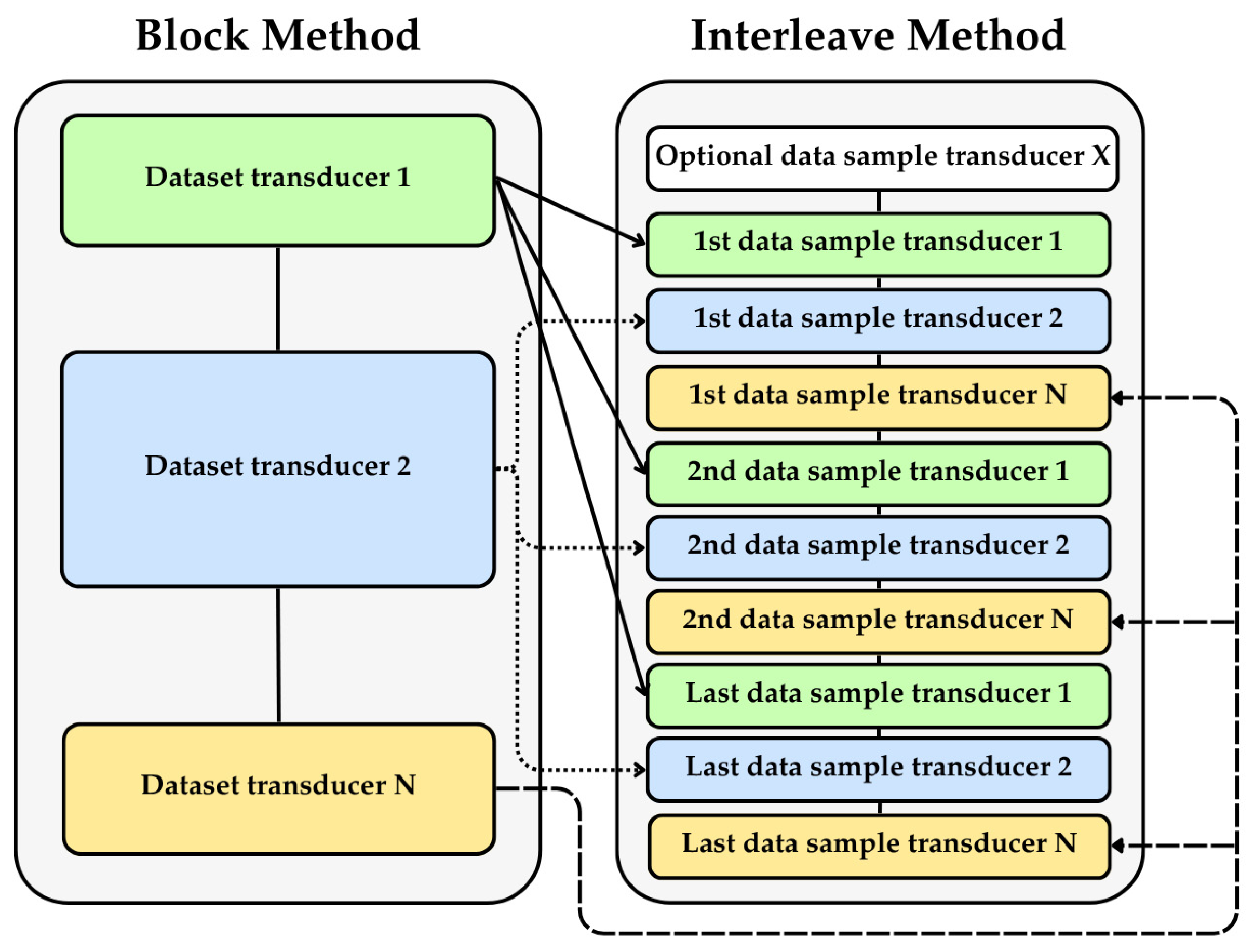
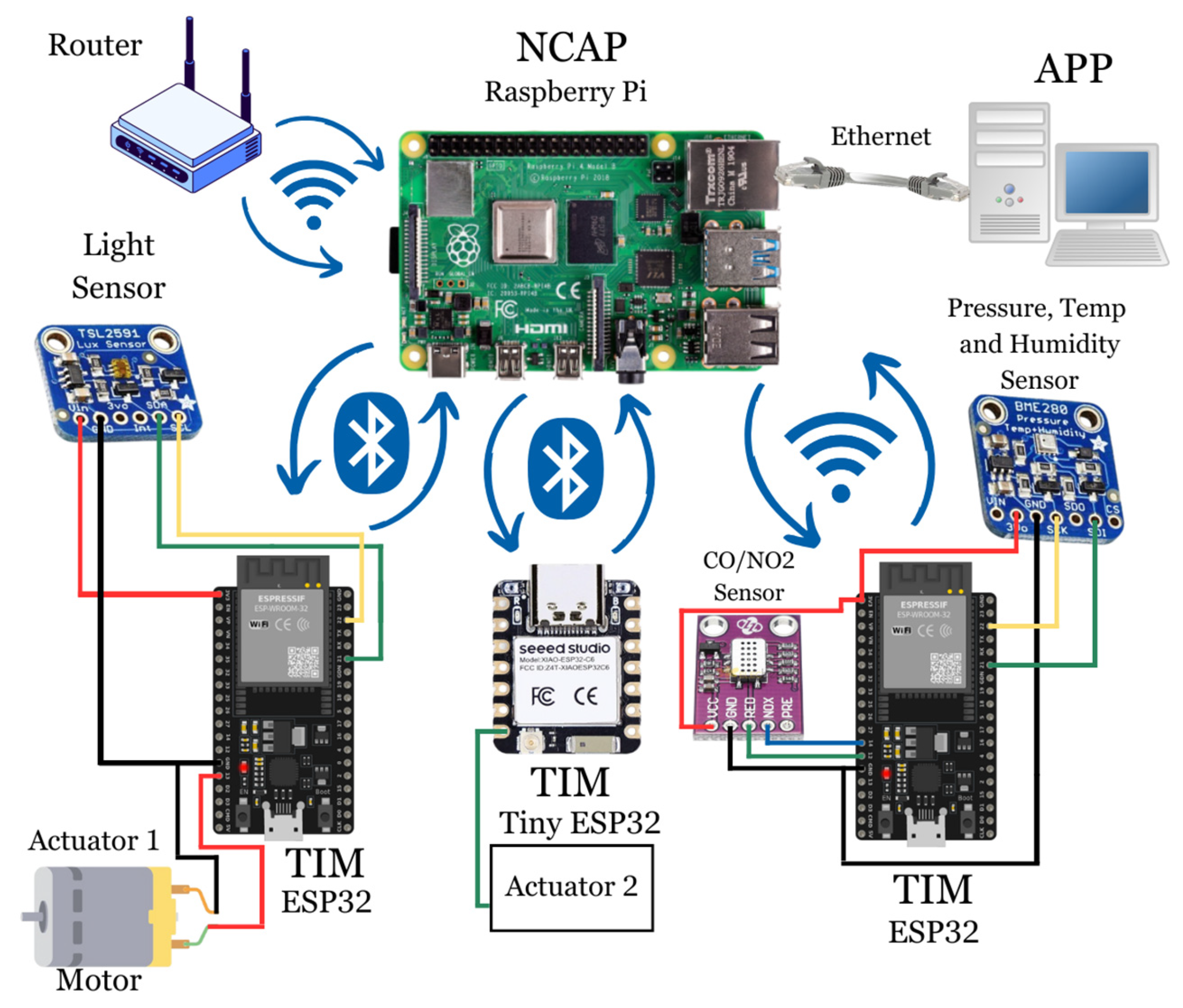
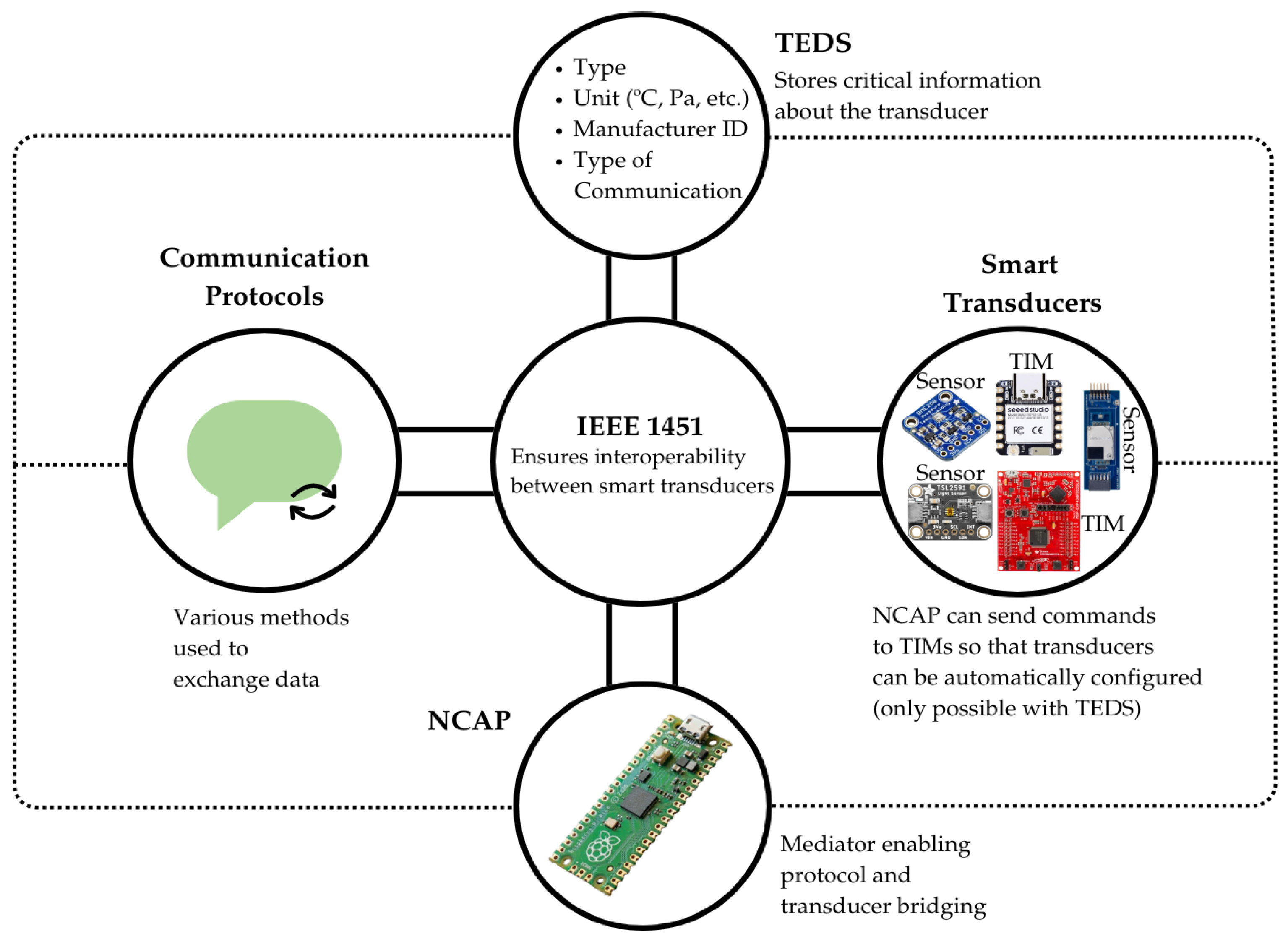
| Ref. | Research | Limitations |
|---|---|---|
| [6] | Technologies employed in Smart cities (such as the collection of data and transmission), while also providing a Strengths/Weaknesses Opportunities/Threats analysis. | Interoperability of networks. Incompatible sensor standards. Networks attacks/data theft. |
| [25] | Review of the employment of DT in smart manufacturing and key differences in employment in a smart city setting. | Interoperability between sensors. Standardisation. Security and privacy. |
| [26] | IoT solution for shelter home security and welfare, exploring the use of IoT technology and sensors for smart monitoring of shelters. | Standardisation among protocols. Standardisation of devices within smart networks. |
| [27] | IoT application layer security, highlighting the several types of attacks and the security of the systems that enable IoT in smart cities. | Heterogeneity of hardware and communication protocols. Different security capabilities across different IoT devices. Low computational power. |
| [28] | Semantic web approaches used in IoT applications in smart cities that focus on enabling semantic interoperability. | Interoperability between smart components. |
| [29] | Solutions and frameworks that enable IoT in a smart city domain. Giving light to the different IoT protocols and devices raises interoperability issues affecting the integration of IoT solutions in smart cities. | Lack of interoperability with use of different communication protocols and IoT devices. |
| [30] | Review of smart cities, with a focus on improving the sustainability of smart cities, giving the example of Parma, which is implementing IoT technology to raise the quality of life of its citizens. | Lack of interoperability in IoT solutions. Vendor lock-in. Lack of open standard-based devices. |
| [31] | Overview of the use of semantics in smart cities, noting that it is essential to find a solution that allows for the integration of different IoT solutions while achieving semantic interoperability. | IoT device diversification. Need for standardised data formats and protocols. |
| [32] | Explores IoT frameworks for smart cities and the respective layers of each architecture, exploring the function of each layer. | Lack of interoperability results in vendor lock-in hardware/software dependency. |
| [33] | IoT in smart agriculture, using the example of an IoT system for agriculture. | Lack of standardisation and interoperability between IoT devices and platforms. |
| [7] | Overview of the protocols employed in IoT and their respective common application in smart cities. | Security. Privacy. Scalability and Interoperability. |
| [8] | Presents two barriers to IoT applications and smart cities: interoperability and security. Underlines that interoperability standards can aid in achieving interoperability between heterogeneous IoT systems. | Lack of interoperability in heterogeneous IoT systems. Lack of security in IoT devices. |
| [9] | Reviews IoT applications and their corresponding challenges, stating that the main challenges in IoT applications impede the stable use of these systems. | Security. Heterogeneity. Interoperability and scalability. |
| Application Domain | Use Cases | Standards/Protocols Used | Relevant IEEE 1451 Sub-Standards |
|---|---|---|---|
| Smart agriculture | Soil monitorisation | Wi-Fi, HTTP, LoRa, UDP, TCP and Wi-Fi Hallow | IEEE 1451.0 IEEE 1451.5 IEEE 1451.5.5 |
| Automatic soil watering | |||
| Smart industry | Factory pollution monitorisation | UART and Wi-Fi | IEEE 1451.0 IEEE 1451.2 IEEE 1451.5 |
| Harbour crane weight monitorisation | |||
| Smart infrastructure | Geotechnical monitoring | NB-IoT, ESP-NOW, TCP/IP, 4G, Wi-Fi, Bluetooth, WAVE (IEEE 802.11p) | IEEE 1451.0 IEEE 1451.5 IEEE 1451.5.10 |
| Structural diagnostics | |||
| V2V | |||
| Smart energy | Energy consumption monitorisation | SPI, Wi-Fi, I2C, UART and Radiofrequency | IEEE 1451.0 IEEE 1451.2 IEEE 1451.5 |
| Monitorisation of transformers | |||
| Smart transportation | Traffic control | LoRa, Wi-Fi, RFID and NFC | IEEE 1451.0 IEEE 1451.5 IEEE 1451.5.5 IEEE 1451.7 |
| smart bus system | |||
| Parking lot space monitorisation | |||
| Smart building | Air quality monitorisation | Wi-Fi, MQTT, TCP/IP and HTTP | IEEE 1451.0 IEEE 1451.1.6 IEEE 1451.5 |
| Fire alarm system | |||
| Energy saving | |||
| Fall detection | |||
| Earthquake detection | |||
| Smart services | Quality of air monitorisation | Wi-Fi | IEEE 1451.0 IEEE 1451.5 |
| Sewer monitorisation | |||
| Waste monitorisation | |||
| Smart health | Health monitorisation | Wi-Fi | IEEE 1451.0 IEEE 1451.5 |
| Monitorisation of comatose patients | |||
| Automated Medication Box |
| Type | TEDS | Characteristics |
|---|---|---|
| Mandatory | Meta | Describes how the TIM functions |
| Transducer Channel | Detailed information about the transducer in a certain transducer channel | |
| Users Transducer Name | Stores the name of the transducer | |
| PHY | Describes the communication protocol used in the network interface and transducer interface | |
| Optional | Calibration | Provides calibration constants to convert the outputs of the sensor into engineering units or convert a value of the engineering units into the form required by the actuator |
| Frequency Response | Provides the frequency response of the transducer channel | |
| Transfer Function | Links series of individual transfer functions together to describe the frequency response of a transducer channel in algorithmic form | |
| Text-based | Provides text-based information about a TIM or transducer channel | |
| Commands | Text-based TEDS that allows for the manufacturer to define additional commands | |
| Identification | Provides data to identify a device or transducer channel within the system | |
| Geographic Location | Text-based TEDS that holds static geographic location information about TIMs | |
| Units extension | Text-based TEDS that provides the extension of SI units | |
| End User Application Specific | Block of memory for the users to store information | |
| Manufacturer-defined | Manufacturers can define TEDS that are not in the standard | |
| Security | Outlines the security protocols used in the IEEE 1451 network and transducer interfaces | |
| Time Synchronisation | Outlines time synchronisation protocols utilised in the IEEE 1451 network and transducer interfaces | |
| Energy | The item is still in process of being created |
| Sub-Standard | Definition |
|---|---|
| IEEE P1451.99 | Defines the method that enables the data sharing and security of messages over transducer networks and other devices, providing an interoperable solution regardless of the type of communication used [71]. |
| IEEE P1451.1.4 | Defines a method for transporting IEEE 1451 messages over a network using the eXtensible Messaging and Presence Protocol. |
| IEEE P1451.1.5 | Defines a method for transporting IEEE 1451 messages over a network using the Simple Network Management Protocol. |
| IEEE P1451.1.6 | Defines a method for transporting IEEE 1451 messages over a network using MQTT [72]. |
| IEEE 1451.0—2024 | Establishes a framework for other sub-standards, defining their fundamental functions. Introduces the important TEDS concept and a standardised object responsible for interfacing transducer networks, characterising the function of NCAP [5]. |
| IEEE 21451-1—2010 | Defines an object model (NCAP) with a network interface for connecting processors to communication networks, sensors, and actuators, stipulating the services and components for the interactions [69]. |
| IEEE P21451-002 | Digital interface that defines the connection and communication between transducers and microprocessors. Also specifies the read and write logic to access TEDS [70]. |
| IEEE 1451.2—1997 | In charge of defining the transducer interface, stipulates wired communication between TIM and NCAP [73]. |
| IEEE 1451.4—2004 | NCAP provides an interface for processing analogue and digital signals. Defines a Mixed-Mode Interface [74]. |
| IEEE 1451.5—2007 | Addresses communication reliability and standards for wireless communication with transducers [68]. In this sub-standard exists its subvariants that define interfaces for LoRa [75], SigFox [76], and NB-IoT [77]. |
| IEEE 1451.7—2010 | Support for radio frequency identification (RFID) and defines the interface between RFID and transducers [78]. |
Disclaimer/Publisher’s Note: The statements, opinions and data contained in all publications are solely those of the individual author(s) and contributor(s) and not of MDPI and/or the editor(s). MDPI and/or the editor(s) disclaim responsibility for any injury to people or property resulting from any ideas, methods, instructions or products referred to in the content. |
© 2025 by the authors. Licensee MDPI, Basel, Switzerland. This article is an open access article distributed under the terms and conditions of the Creative Commons Attribution (CC BY) license (https://creativecommons.org/licenses/by/4.0/).
Share and Cite
Rita, J.; Salvado, J.; Rocha, H.d.; Espírito-Santo, A. A Comprehensive Review of IoT Standards: The Role of IEEE 1451 in Smart Cities and Smart Buildings. Smart Cities 2025, 8, 108. https://doi.org/10.3390/smartcities8040108
Rita J, Salvado J, Rocha Hd, Espírito-Santo A. A Comprehensive Review of IoT Standards: The Role of IEEE 1451 in Smart Cities and Smart Buildings. Smart Cities. 2025; 8(4):108. https://doi.org/10.3390/smartcities8040108
Chicago/Turabian StyleRita, José, José Salvado, Helbert da Rocha, and António Espírito-Santo. 2025. "A Comprehensive Review of IoT Standards: The Role of IEEE 1451 in Smart Cities and Smart Buildings" Smart Cities 8, no. 4: 108. https://doi.org/10.3390/smartcities8040108
APA StyleRita, J., Salvado, J., Rocha, H. d., & Espírito-Santo, A. (2025). A Comprehensive Review of IoT Standards: The Role of IEEE 1451 in Smart Cities and Smart Buildings. Smart Cities, 8(4), 108. https://doi.org/10.3390/smartcities8040108





